 |
| |
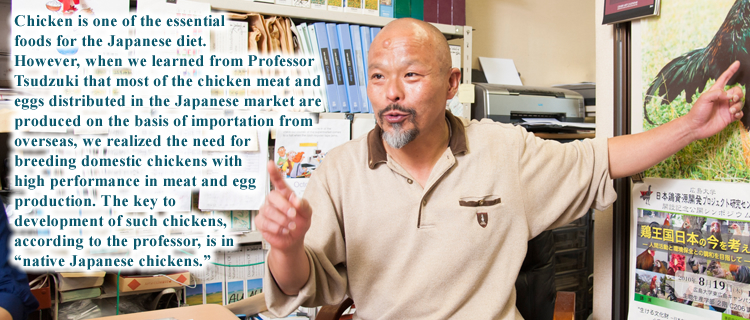 |
| |
|
「Endeavoring to develop high-performance chicken breeds in Japan to
improve food security」
|
| |
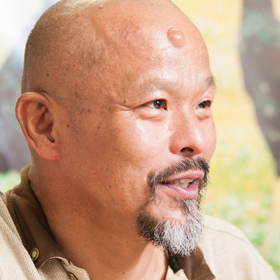 |
|
Japan’s self-sufficiency rate in chicken eggs is generally
believed high—about 95% according to the Ministry of Agriculture,
Forestry and Fisheries. Professor Tsudzuki, however, presents an
entirely different picture. “It is actually only 6% or so. As for
chicken meat, our self-sufficiency rate is said to be about 70%. In
reality, it is less than 2%. In other words, 98% of chicken meat is
imported.” To explain these disparities in numbers, let’s look into
the lineage of utility chickens distributed in Japan.
From chicken eggs sold in retail stores, we can
trace back the lineage of utility chickens to ‘commercial chickens’
kept at chicken farms, then to ‘parent stock’, ‘grandparent stock’,
‘great-grandparent stock’, and finally to ‘pedigree stock’.
Professor Tsudzuki says it is mainly the parent stock imported as
chicks that actually produce chicken meat and eggs in our country.
That explains why our self-sufficiency rates in chicken meat and
eggs in the real sense are those shown above.
|
|
“So if avian influenza breaks out, for example, chicken
imports will stop instantly. Besides, global warming and other
global climate changes are feared to cause other diseases or
reduce the productivity of American and European breeds. Since
chicken meat and eggs are one of our important protein sources,
we will be in big trouble if we remain heavily dependent on
imported chickens. That is why we must develop high-quality
pedigree stock here in Japan,” says Professor
Tsudzuki.
Japan has many native chicken breeds, but their egg and meat
productivity is not as high as that of improved breeds. To address
the lack of high-performance native chickens, Professor Tsuzuki and
his team are working to establish new domestic breeds. According to
Professor Tsudzuki, “Conventional breeding techniques lack accuracy
and speed. In the case of eggs, for example, we typically use a
‘selective breeding’ technique with which we pick out hens with
higher egg productivity from every generation. However, this process
takes many generations of chickens and 30–40 years of efforts to
achieve the intended results. Meanwhile, this method also lacks
accuracy because the stock being bred can be affected by
environmental factors such as temperature and feedstuff during the
intervening period. That is why we decided it best to identify
desirable genes by eliminating all possible environmental
effects.
|
|
|
「The one and only university in Japan engaged in QTL analysis to
locate desirable loci」
|
| |
What makes his endeavor possible is the QTL analysis
introduced in the 1990s. For the past 15–16 years, Professor Tsuzuki has
conducted research in which he uses this method to identify loci that
control chickens’ productivity such as egg-laying rates and meat
productivity. His team is the only group in Japan that is engaged in
this kind of research project.
“QTL analysis uses DNA data to find out what kinds of
genes are in what position of the chromosome,” says the professor.
“Based on these analysis results, we are trying to carry out ‘DNA
breeding’ by means of ‘marker assisted selection.’”
However, QTL analysis can reveal only the locations
of genes, called “loci.” If the analysis procedures are refined even
further in the future, however, the QTL method will be able to show not
only the location but also the nature of genes. Using such genetic
information, it will become possible to improve specific traits of
animals in a more accurate and speedy manner. |
|
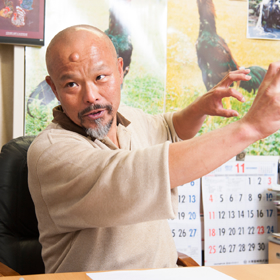 |
“I myself have discovered about
700 loci since I started my research using QTL analysis in 1997,” says
Professor Tsuzuki. “Some of them concern egg-laying rates and others
body weight. Typically, chickens’ weight changes are checked up until
about 7 weeks after birth. But here, we check chickens’ weight until
they are 64 weeks. Specifically, we weigh them once a week until they
become 20 weeks and after that once a month. No other place in the world
monitors chicken weight for such a long period of time. We have also
identified the loci that concern the size and weight of eggs as well as
the color and size of yolks. All of this suggests that our research
efforts have produced substantial academic results. What has greatly
helped us make these accomplishments is that we have used Japanese
native chickens for our research.”
Although it is technically possible to improve
chicken breeds based on the results obtained so far, the lack of
financial and human resources delays such endeavor. Meanwhile,
challenges remain in revealing the nature of relevant genes and
improving chicken breeds by using such genetic information. Graduate
students, come and join Professor Tsudzuki’s lab! |
|
| |
|
「Unending quest for developing high-performance utility chicken breeds and
the role as the nation’s leading Japanese chicken research institute」
|
| |
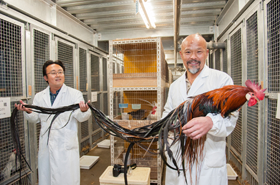
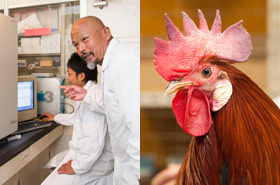 |
|
In the QTL analysis, two different breeds are crossed to produce
their children and grandchildren. Then, DNAs of the three
generations of chickens are analyzed all at once. And if useful gene
loci are identified, there are two options—either to transfer
relevant genes to Japanese breeds or to high-performance breeds of
European or American descent that are kept in Japan. Because the
former procedure is time-consuming, the latter, more efficient
procedure tends to be chosen.
“If only we have enough money, we will be able to
develop marketable breeds in 5–10 years. In just 20 years after the
start of the breed improvement effort, we should be able to
establish pedigree stock. And if we use next-generation sequencing
methods, we can speed up the breeding process even further,”
comments Professor Tsudzuki.
While engaged in these research activities,
Professor Tsudzuki studies genetic diversity of chickens. Since
2010, he has also served as director of the Japanese Avian
Bioresource Project Research Center. The center keeps about 4,000
individual chickens and quails on the HU campus, including as many
as 120 kinds of chickens.
Professor Tsudzuki says, “Our center aims to
develop high-quality domestic grandparent stock, while preserving
Japanese indigenous breeds, maintaining genetic diversity, and
passing the Japanese chicken culture on to future generations. The
research center is open to the public and visitors are always
welcome. I would like to see as many people as possible realize the
wonderful qualities of native Japanese chickens.”
|
|
| |
| Masaoki Tsudzuki |
Professor
Animal Breeding and Genetics Laboratory
Hiroshima University School of Applied Biological Science
1983: Graduated from Department of Animal Science, School of Agriculture, Nagoya
University
1988: Completed the doctoral degree program at the Graduate School of Agricultural Sciences,
Nagoya University
April 1, 1989 – March 31, 1990: Fellow, Research Fellowship for Young Scientists, Japan
Society for the Promotion of Science
April 1, 1990 – March 31, 1996: Assistant Professor, Laboratory of Experimental Animal
Science, Department of Veterinary Science, School of Agriculture, Osaka Prefecture
University
April 1, 1996 – March 31, 2002: Associate Professor, Department of Applied Biological
Science, School of Applied Biological Science, Hiroshima University
April 1, 2002 – September 30, 2004: Associate Professor, Graduate School of Biosphere
Science, Hiroshima University
October 1, 2004 – : Professor, School of Applied Biological Science, Hiroshima
University
April 1, 2006 – : Professor, Graduate School for International Development and Cooperation,
Hiroshima University (concurrent post with above)
Posted on May 22, 2013
|
| |






